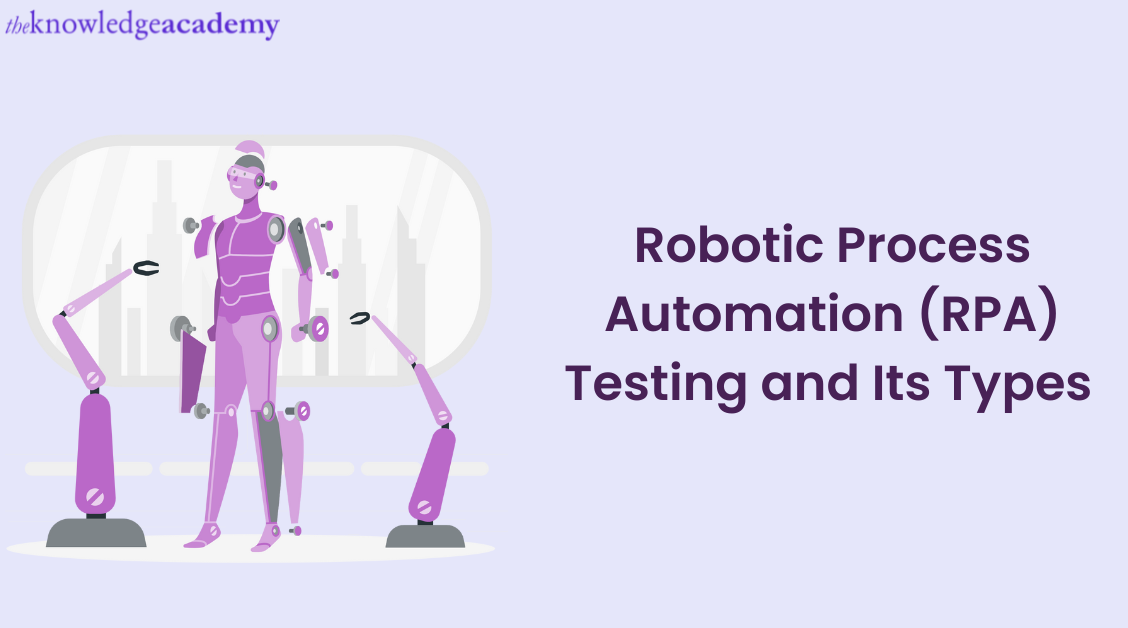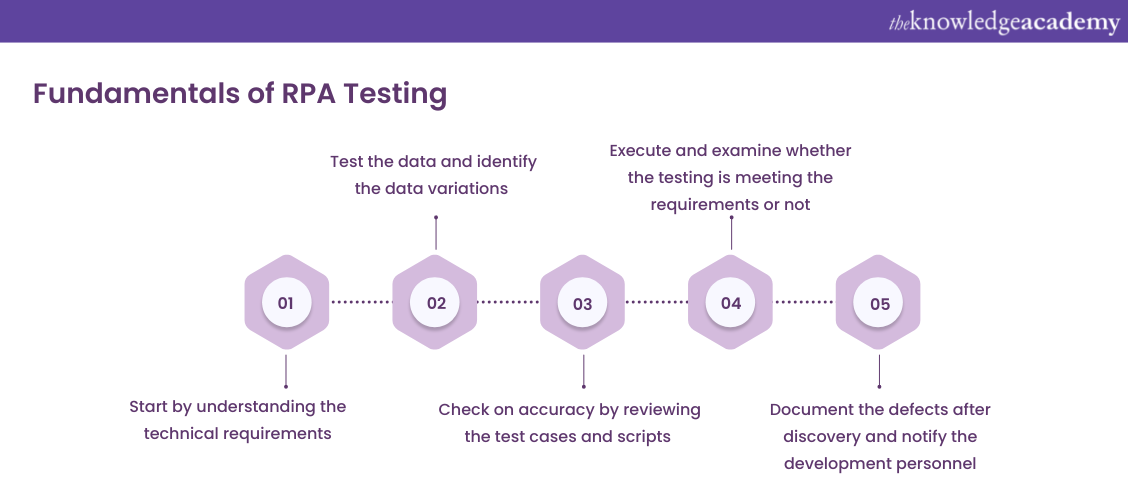We may not have the course you’re looking for. If you enquire or give us a call on +61 1-800-150644 and speak to our training experts, we may still be able to help with your training requirements.
We ensure quality, budget-alignment, and timely delivery by our expert instructors.

Robotic Process Automation (RPA) Testing has become an essential part of the software development process applicable in various industries. In today’s technology-driven world, RPA is transforming the way businesses operate. It involves using software robots or bots that can perform repetitive and mundane tasks with high accuracy and speed.
RPA frees up valuable time for employees to focus on more critical tasks. RPA Testing involves verifying the efficiency, accuracy, and reliability of RPA Bots. The testing process includes functional testing, security testing, and performance testing.
According to Grand View Research, the world’s RPA market will reach 25,725 million GBP by 2030 and expand at a CAGR of 39.9% from 2023 to 2030. As various industries are rapidly adopting this technology, RPA Testing has become essential to ensure the success of RPA implementation.
Whether you’re a Business Owner, Software Developer, or Quality Assurance Professional, understanding RPA Testing is necessary to ensure proper RPA implementation. Read this blog further to understand everything about RPA Testing, its types and fundamentals.
Table of Contents
1) What is RPA Testing?
2) Types of RPA Testing
3) What are the fundamentals of RPA Testing?
a) Understanding the requirements
b) Testing the data
c) Test cases and scripts
d) Execution
e) Defect management
4) Steps of RPA Testing
5) Conclusion
What is RPA Testing?
RPA Testing focuses on ensuring that the RPA tools, including the Programming Languages for RPA UiPath, are functioning as intended. It involves evaluating RPA bots' efficiency, accuracy, and reliability by testing various scenarios and workflows. The goal of RPA Testing is to ensure that the bots are performing tasks correctly and producing the desired results. RPA Bots are used to automate tasks that are typically performed manually.
RPA Testing typically involves:
a) Creating test cases and scripts.
b) Executing them.
c) Analysing the results to spot any issues or defects.
Overall, RPA Testing is an essential step in developing and deploying RPA solutions, as it helps ensure that these tools, and their various applications of RPA, are providing and delivering on their promises.
Learn the fundamentals and explore the realm of Robotic Process Automation. Sign up right away for our training on Robotic Process Automation using UiPath!
Types of RPA Testing
It is necessary to test any software properly before taking it into use. This practice applies to all software, including RPA Blue Prism, which functions automatically. You can do tests on your own and check how well the code works. Additionally, you can create test cases and check the efficiency of the code. There are two types of RPA Testing: Business Process testing (using RPA tools to test the automated business process) and business components testing (using RPA tools to test other business components).
What are the fundamentals of RPA Testing?
As more companies transition to implementing RPA in their organizations, it’s increasingly essential to refer to an RPA implementation checklist to ensure all key aspects are covered. Here are a few fundamental considerations for RPA testing in your organization.

Understanding the business processes
One of the most common challenges in developing an automation solution is understanding the requirements before and after development. This is an important stage that establishes the foundation for subsequent testing stages. In this stage, you should focus on understanding process flow, design flows, technical documentation, and leveraging a Blue Prism Work Queue Guide to enhance process management and efficiency.
Looking at the Process Definition Document (PDD), Solution Design Document (SDD), and other documents made during the design phase is the best way to understand the process. In this context, understanding the difference between RPA and Machine Learning can clarify how both technologies contribute differently to automating and optimizing business processes. The automation testing team must understand all the process flows and technical requirements. After understanding the process, the testers can make scenarios to test code and see whether it follows the business rules.
Test scenarios
It is time to check whether the automation matches the business rules outlined in the design documents. For a good test scenario, you must ensure it is simple and short. Additionally, ensure the test scenario aligns with the business rules given in PDD or SDD. Refer to the SDD to understand which test scenarios need to be validated. It is necessary to double-check the SDD to ensure you do not miss any information.
Test cases and scripts
This step is about organising the information you collected earlier. The test script has a lot of different tests with specific results, usually in Excel. It includes the scenarios you are testing, the data you need for testing, what you expect to happen, what actually happens, and whether it passes or fails. It is essential to write the script clearly to avoid missing any crucial tests. Getting it reviewed and seeking suggestions from the design team is necessary, as the process is complex, and you can ensure nothing is left behind.
Testing the data
Test data is crucial in automation testing to ensure the testing process continues. Without valid test data, the testing results may not be accurate. Inaccurate test data may cause problems and errors that may cause a delay in the testing process. That is why knowing what kind of test data and format is essential for a successful testing cycle. Understanding this will ensure the testing process runs smoothly and efficiently, with the best possible results.
Defect management
The main objective of conducting automation RPA Testing services is to identify any flaws in the process and/or system. This is a fundamental requirement that applies to all the RPA Testing processes.
Once the testing team discovers defects, they document them and notify the development personnel. The testing team needs to be careful in their examination to ensure that necessary changes and adjustments to the processes and/or system can be carried out swiftly, with as much pertinent information as possible.
The information includes writing the test case descriptively, taking screenshots of the error screen, recording the failed process, attaching the input file used for testing, and output data produced by the automation.
Steps of RPA Testing
There are some steps you can follow to test software in RPA using UiPath Studio; these are as follows:
As discussed above, testing the software before deploying it is essential. Hence, the Tester or Developer should first select the software they want to test. After that, right-click on the Main.xaml under the project panel. From the list that will be opened, click on the select the Create Test Case option.
The test case structure has three sections-Given, When, and Then. In the Given section, Input should be given to test the process. In the When section, use the RPA process through which testing will be done. Finally, the Then section in which to get the required outcome verification will be done.
After completing all the above processes, we get the result that shows the percentage of activities covered by the Testcase from the workflow.
Don’t let tough Software developer interview questions catch you off guard. Review and be ready to tackle anything that comes your way.
Conclusion
RPA Testing may be a daunting task, but it is a vital stage in the deployment process that must be done correctly to ensure the success of a project. Whether you're considering an RPA or testing solution for any organisational process, implementing an RPA-based framework can be brilliant. It provides an efficient, future-proof solution for automating your business systems and processes. An RPA-based solution can streamline your workflow, increase efficiency, and save time and resources. So, invest in this technology to take your business to the next level.
Know the creation of web-integrated Open Span solutions. Register for ours OpenSpan RPA Training!
Upcoming Business Analysis Resources Batches & Dates
Date
 Robotic Process Automation using UiPath
Robotic Process Automation using UiPath
Thu 22nd May 2025
Thu 24th Jul 2025
Thu 4th Sep 2025
Thu 11th Dec 2025
Thu 12th Feb 2026
Thu 9th Apr 2026
Thu 30th Jul 2026
Thu 8th Oct 2026






 Top Rated Course
Top Rated Course



 If you wish to make any changes to your course, please
If you wish to make any changes to your course, please


